Pro Nets Technology WR750R Wireless Router User Manual 20100913 v1 WR750
Pro-Nets Technology Corporation Wireless Router 20100913 v1 WR750
Contents
- 1. User manual 1 of 2
- 2. User manual 2 of 2
- 3. User manual
User manual 2 of 2
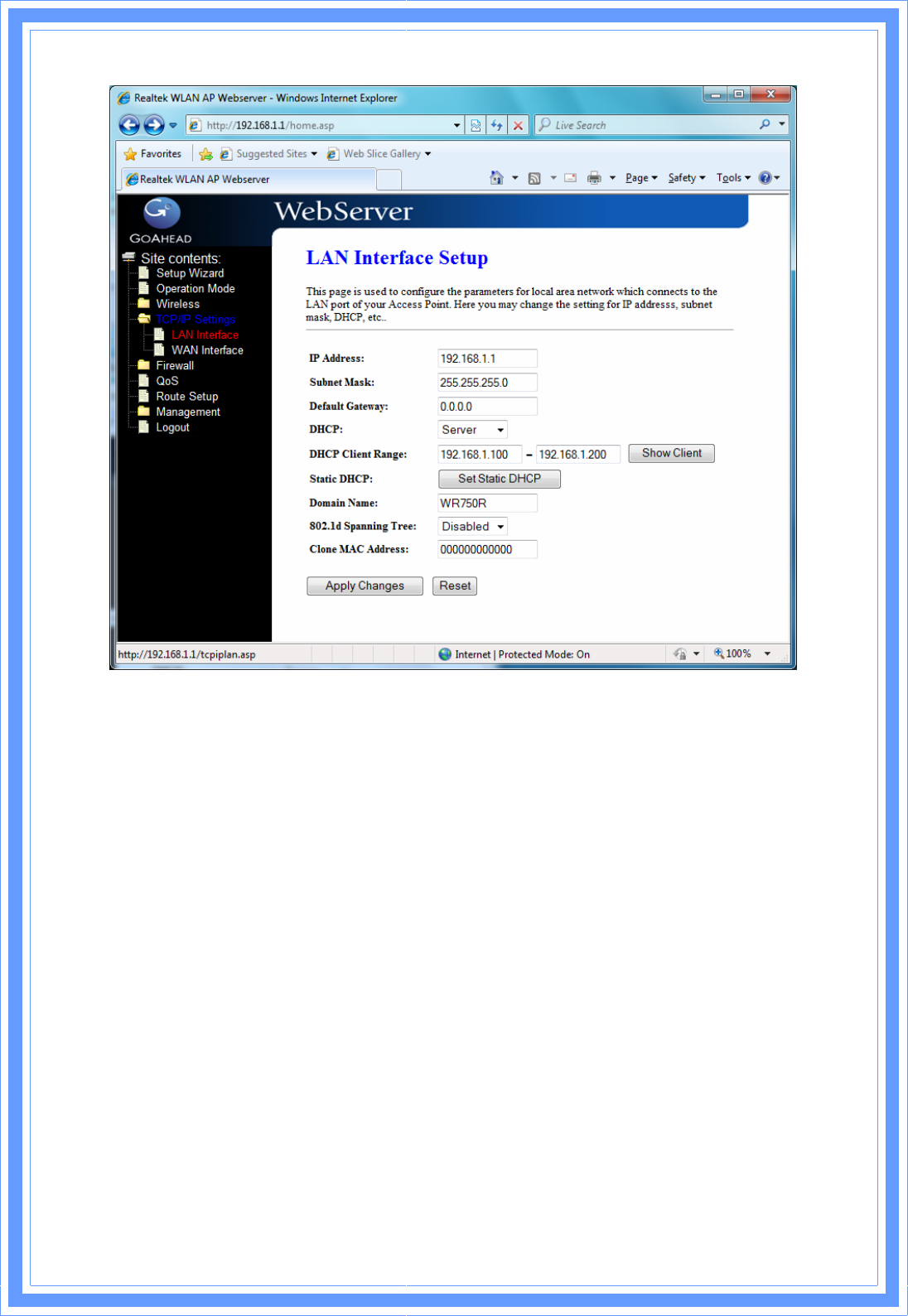
3
9
IP Address: Fill in the IP address of LAN interfaces of this WLAN Access Point.
Subnet Mask: Fill in the subnet mask of LAN interfaces of this WLAN Access Point.
Default Gateway: Fill in the default gateway for LAN interfaces out going data
packets.
DHCP: Click to select Disabled,Client or Server in different operation mode of wireless
Access Point.
DHCP Client Range: Fill in the start IP address and end IP address to allocate a range
of IP addresses; client with DHCP function set will be assigned an IP address from the
range.
Show Client: Click to open the Active DHCP Client Table window that shows the active
clients with their assigned IP address, MAC address and time expired information.
[Server mode only]
Static DHCP: Select enable or disable the Static DHCP function from pull-down menu.
[Server mode only]
Set Static DHCP: Manual setup Static DHCP IP address for specific MAC address.
[Server mode only]
Domain Name: Assign Domain Name and dispatch to DHCP clients. It is optional
field.
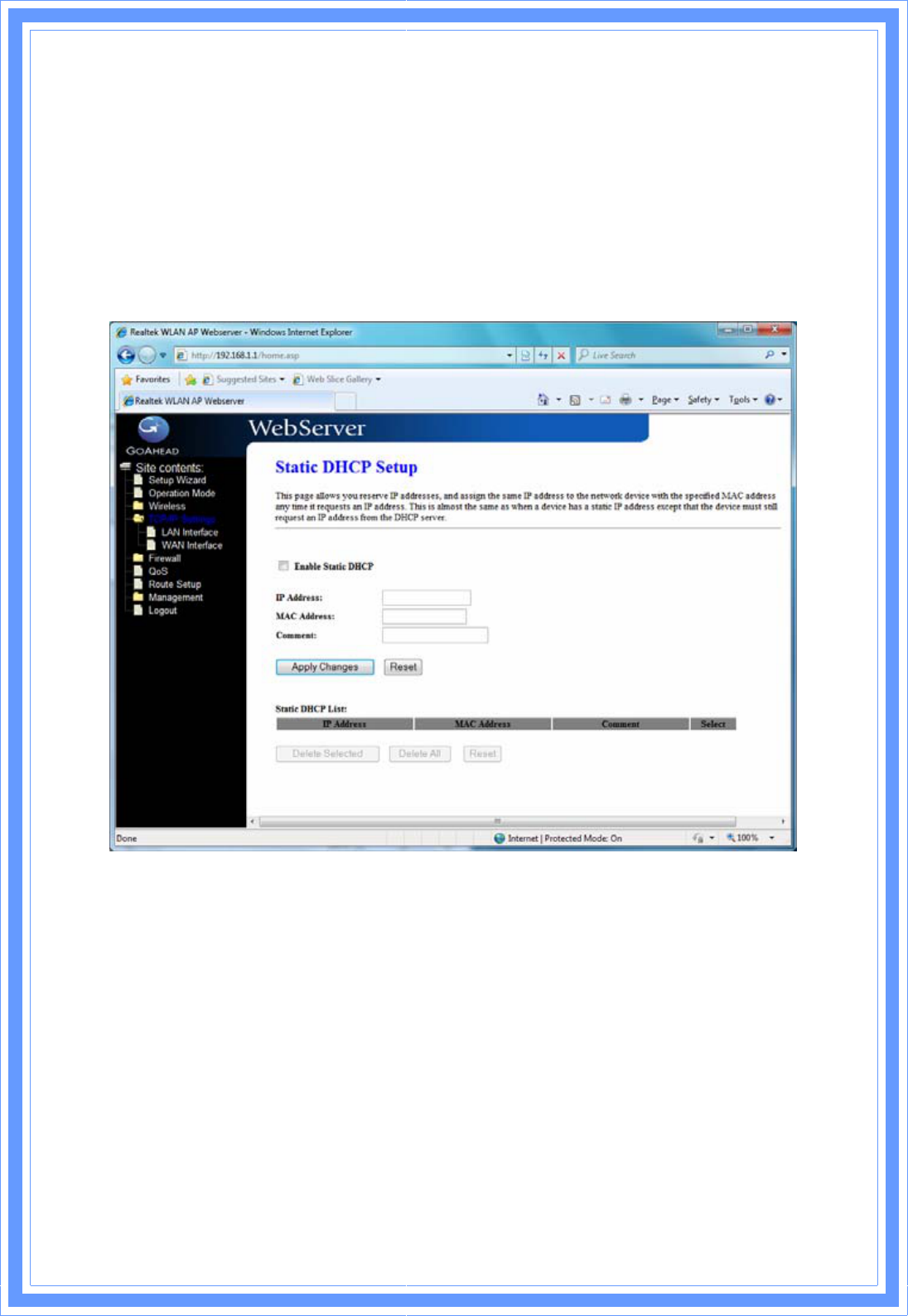
4
0
802.1d Spanning Tree: Select enable or disable the IEEE 802.1d Spanning Tree
function from pull-down menu.
Clone MAC Address: Fill in the MAC address that is the MAC address to be cloned.
3.5.1.1 Static DHCP Setup
This page allows you reserve IP address and assign the same IP address to the network
device with the specified MAC address any time it requests an IP address. This is almost
the same as when a device has a static IP address except that the device must still
request an IP address from the DHCP server.
IP Address: If you select the Set Static DHCP on LAN interface, fill in the IP address for
it.
MAC Address: If you select the Set Static DHCP on LAN interface, fill in the MAC
address for it.
Comment: Fill in the comment tag for the registered Static DHCP.
Static DHCP List: It shows IP Address MAC Address from the Static DHCP.
Delete Selected: Click to delete the selected clients that will be removed from the
Static DHCP list.
Delete All: Click to delete all the registered clients from the Static DHCP list.
Reset: Click the Reset button to abort change and recover the previous configuration
setting.
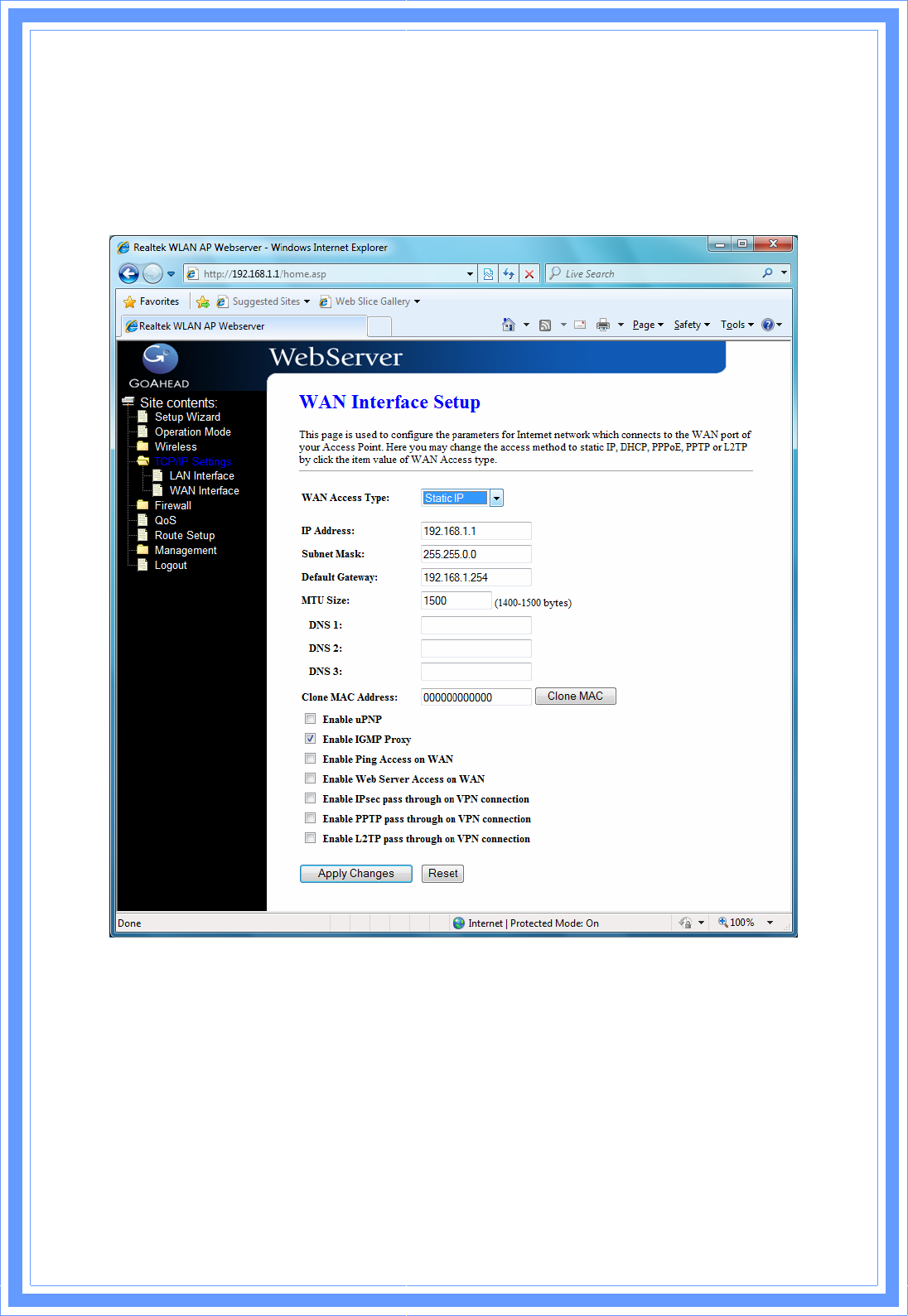
41
3.5.2 WAN Interface
This page is used to configure the parameters for wide area network that connects to the
WAN port of your WLAN Broadband Router. Here you may change the access method
to Static IP, DHCP, PPPoE or PPTP by click the item value of WAN Access Type.
[Static IP]
Static IP: Click to select Static IP support on WAN interface. There are IP address,
subnet mask and default gateway settings need to be done.
IP Address: If you select the Static IP support on WAN interface, fill in the IP address
for it.
Subnet Mask: If you select the Static IP support on WAN interface, fill in the subnet
mask for it.
Default Gateway: If you select the Static IP support on WAN interface, fill in the
default gateway for WAN interface out going data packets.
MTU Size: Fill in the mtu size of MTU Size. The default value is 1400.

4
2
DNS 1: Fill in the IP address of Domain Name Server 1.
DNS 2: Fill in the IP address of Domain Name Server 2.
DNS 3: Fill in the IP address of Domain Name Server 3.
Clone MAC Address: Fill in the MAC address that is the MAC address to be cloned.
Enable uPNP: Click the checkbox to enable uPNP function.
Enable IGMP Proxy: Click the checkbox to enable IGMP Proxy.
Enable Ping Access on WAN: Click the checkbox to enable WAN ICMP response.
Enable Web Server Access on WAN: Click the checkbox to enable web
configuration from WAN side.
Enable IPsec pass through on VPN connection: Click the checkbox to enable
IPSec packet pass through.
Enable PPTP pass through on VPN connection: Click the checkbox to enable
PPTP packet pass through.
Enable L2TP pass through on VPN connection: Click the checkbox to enable
L2TP packet pass through.
Apply Changes: Click the
Apply Changes
button to complete the new
configuration setting.
Reset: Click the
Reset
button to abort change and recover the previous configuration
setting.
[DHCP Client]
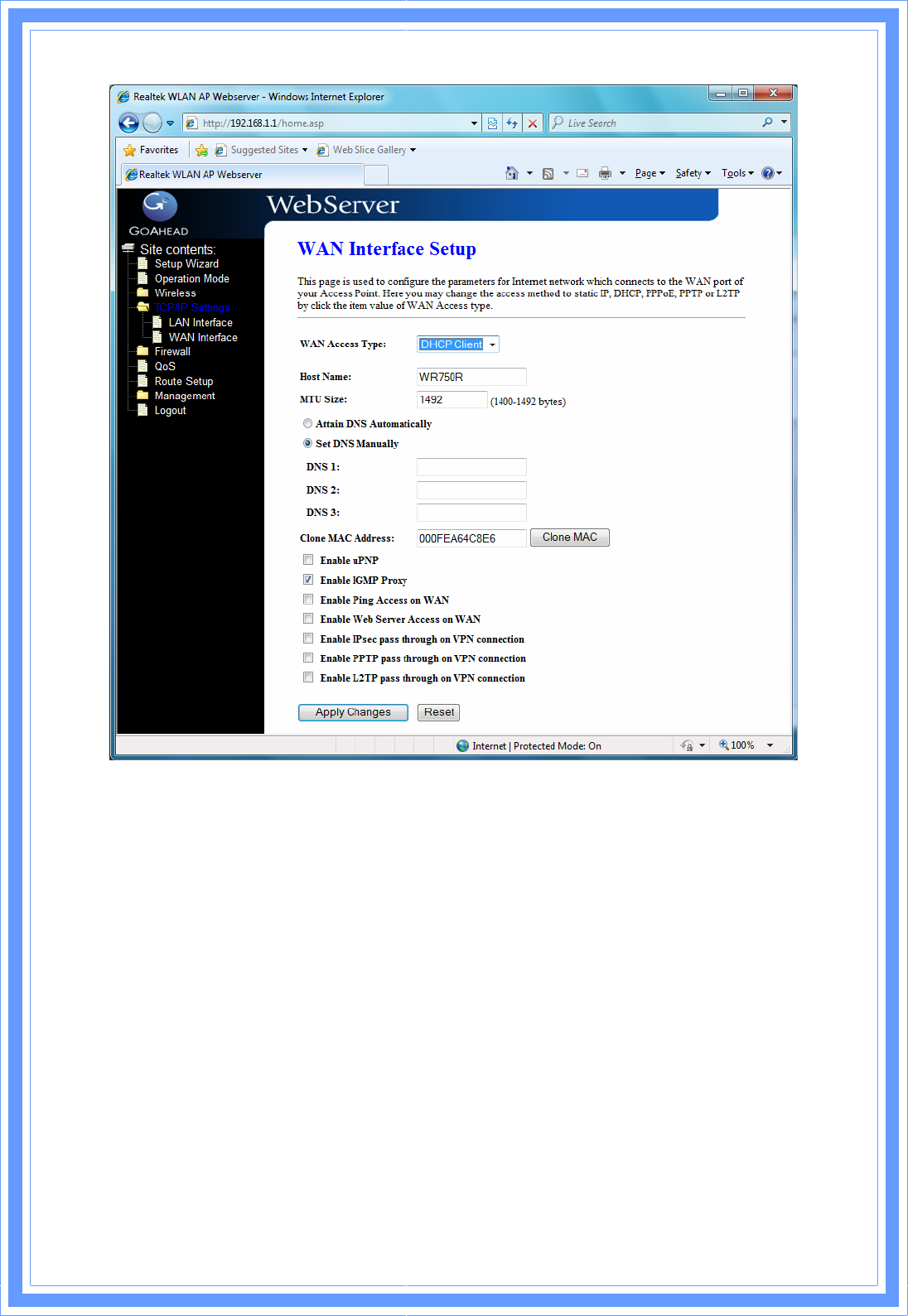
4
3
DHCP Client: Click to select DHCP support on WAN interface for IP address assigned
automatically from a DHCP server.
Host Name: Fill in the host name of Host Name. The default value is empty.
MTU Size: Fill in the mtu size of MTU Size. The default value is 1400.
Attain DNS Automatically: Click to select getting DNS address for
DHCP
support.
Please select
Set DNS Manually
if the
DHCP
support is selected.
Set DNS Manually: Click to select getting DNS address for
DHCP
support.
DNS 1: Fill in the IP address of Domain Name Server 1.
DNS 2: Fill in the IP address of Domain Name Server 2.
DNS 3: Fill in the IP address of Domain Name Server 3.
Clone MAC Address: Fill in the MAC address that is the MAC address to be cloned.
Enable uPNP: Click the checkbox to enable uPNP function.
Enable IGMP Proxy: Click the checkbox to enable IGMP Proxy.
Enable Ping Access on WAN: Click the checkbox to enable WAN ICMP response.
Enable Web Server Access on WAN: Click the checkbox to enable web

4
4
configuration from WAN side.
Enable IPsec pass through on VPN connection: Click the checkbox to enable
IPSec packet pass through.
Enable PPTP pass through on VPN connection: Click the checkbox to enable
PPTP packet pass through.
Enable L2TP pass through on VPN connection: Click the checkbox to enable
L2TP packet pass through.
Apply Changes: Click the
Apply Changes
button to complete the new
configuration setting.
Reset: Click the
Reset
button to abort change and recover the previous configuration
setting.
[PPPoE]
PPPoE: Click to select PPPoE support on WAN interface. There are user name,
password, connection type and idle time settings need to be done.
User Name: If you select the PPPoE support on WAN interface, fill in the user name
and password to login the PPPoE server.
Password: If you select the PPPoE support on WAN interface, fill in the user name and
password to login the PPPoE server.
Service Name: Fill in the service name of Service Name. The default value is empty.
Connection Type: Select the connection type from pull-down menu. There are
Continuous,Connect on Demand
and
Manual
three types to select.
Continuous
connection type means to setup the connection
through PPPoE protocol whenever this WLAN AP Router is
powered on.
Connect on Demand
connection type means to setup the
connection through PPPoE protocol whenever you send the data
packets out through the WAN interface; there are a watchdog
implemented to close the PPPoE connection while there are no
data sent out longer than the idle time set.
Manual
connection type means to setup the connection through
the PPPoE protocol by clicking the
Connect
button manually,
and clicking the
Disconnect
button manually.
Idle Time: If you select the
PPPoE
and
Connect on Demand
connection type, fill in
the idle time for auto-disconnect function. Value can be between 1 and 1000 minutes.
MTU Size: Fill in the MTU size of MTU Size. The default value is 1400.
Attain DNS Automatically: Click to select getting DNS address for
DHCP
support.
Please select
Set DNS Manually
if the
DHCP
support is selected.

4
5
Set DNS Manually: Click to select getting DNS address for
DHCP
support.
DNS 1: Fill in the IP address of Domain Name Server 1.
DNS 2: Fill in the IP address of Domain Name Server 2.
DNS 3: Fill in the IP address of Domain Name Server 3.
Clone MAC Address: Fill in the MAC address that is the MAC address to be cloned.
Enable uPNP: Click the checkbox to enable uPNP function.
Enable IGMP Proxy: Click the checkbox to enable IGMP Proxy.
Enable Ping Access on WAN: Click the checkbox to enable WAN ICMP response.
Enable Web Server Access on WAN: Click the checkbox to enable web
configuration from WAN side.
Enable IPsec pass through on VPN connection: Click the checkbox to enable
IPSec packet pass through.
Enable PPTP pass through on VPN connection: Click the checkbox to enable
PPTP packet pass through.
Enable L2TP pass through on VPN connection: Click the checkbox to enable
L2TP packet pass through.
Apply Changes: Click the
Apply Changes
button to complete the new
configuration setting.
Reset: Click the
Reset
button to abort change and recover the previous configuration
setting.
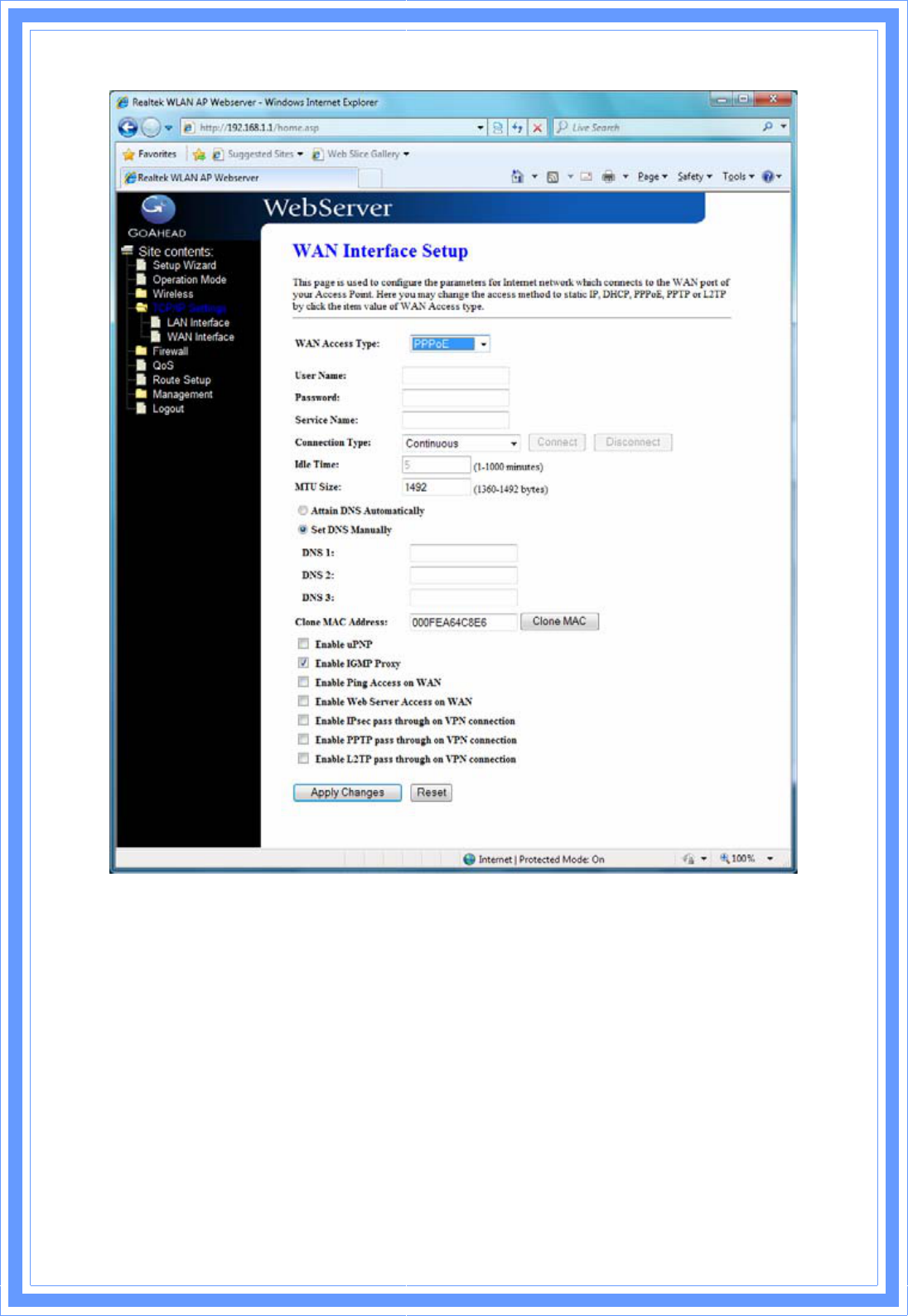
4
6
[PPTP]
PPTP: Allow user to make a tunnel with remote site directly to secure the data
transmission among the connection. User can use embedded PPTP client supported by
this router to make a VPN connection.
Get the WAN IP Automatically: Click to select PPTP Dynamic support on WAN
interface for IP address assigned automatically from a PPTP server.
IP Address: If you select the PPTP support on WAN interface, fill in the IP address for it.
Subnet Mask: If you select the PPTP support on WAN interface, fill in the subnet mask
for it.
Gateway: If you select the Static PPTP support on WAN interface, fill in the gateway
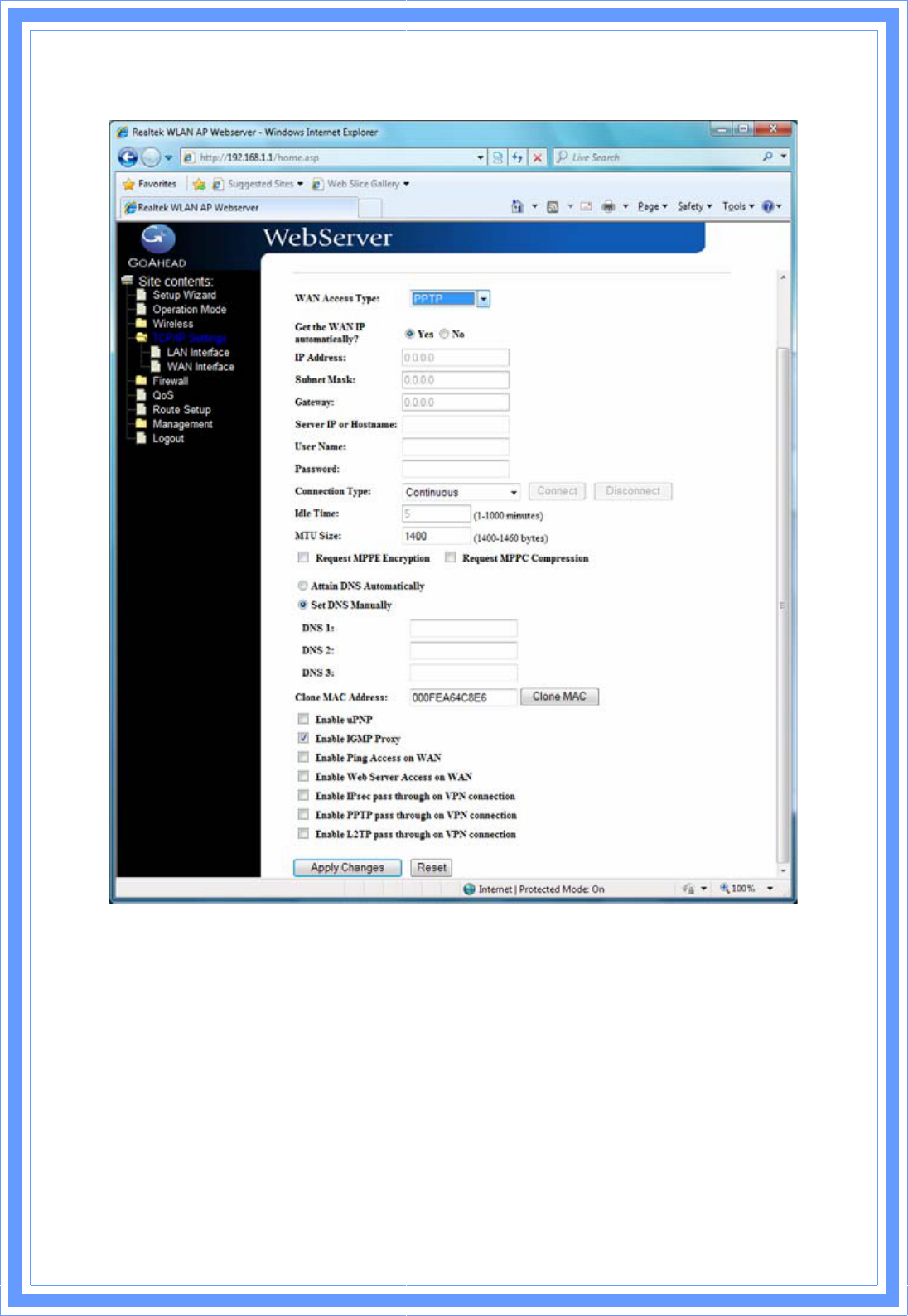
47
for WAN interface out going data packets.
Server IP Address : Enter the IP address of the PPTP Server.
Server Domain Name: Assign Domain Name and dispatch to PPTP servers. It is
optional field.
User Name: If you select the PPTP support on WAN interface, fill in the user name and
password to login the PPTP server.
Password: you select the PPTP support on WAN interface, fill in the user name and
password to login the PPTP server.
MTU Size: Fill in the mtu size of MTU Size. The default value is 1400.
Request MPPE Encryption: Click the checkbox to enable request MPPE encryption.
Attain DNS Automatically: Click to select getting DNS address for
PPTP
support.

4
8
Please select
Set DNS Manually
if the
PPTP
support is selected.
Set DNS Manually: Click to select getting DNS address for
PPTP
support.
DNS 1: Fill in the IP address of Domain Name Server 1.
DNS 2: Fill in the IP address of Domain Name Server 2.
DNS 3: Fill in the IP address of Domain Name Server 3.
Clone MAC Address: Fill in the MAC address that is the MAC address to be cloned.
Enable uPNP: Click the checkbox to enable uPNP function.
Enable IGMP Proxy: Click the checkbox to enable IGMP Proxy.
Enable Ping Access on WAN: Click the checkbox to enable WAN ICMP response.
Enable Web Server Access on WAN: Click the checkbox to enable web
configuration from WAN side.
Enable IPsec pass through on VPN connection: Click the checkbox to enable
IPSec packet pass through.
Enable PPTP pass through on VPN connection: Click the checkbox to enable
PPTP packet pass through.
Enable L2TP pass through on VPN connection: Click the checkbox to enable
L2TP packet pass through.
Apply Changes: Click the
Apply Changes
button to complete the new
configuration setting.
Reset: Click the
Reset
button to abort change and recover the previous configuration
setting.
Note: PPTP Gateway Your ISP will provide you with the Gateway IP Address. If your
LAN has a PPTP gateway, then enter that PPTP gateway IP address here. If you do not
have PPTP gateway then enter the ISP’s Gateway IP address above.
[L2TP]
L2TP: Allow user to make a tunnel with remote site directly to secure the data
transmission among the connection. User can use embedded L2TP client supported by
this router to make a VPN connection.
Get the WAN IP Automatically: Click to select L2TP Dynamic support on WAN
interface for IP address assigned automatically from a PPTP server.
IP Address: If you select the L2TP support on WAN interface, fill in the IP address for it.
Subnet Mask: If you select the L2TP support on WAN interface, fill in the subnet mask
for it.
Gateway: If you select the Static L2TP support on WAN interface, fill in the gateway
for WAN interface out going data packets.
Server IP Address: Enter the IP address of the L2TP Server.
Server Domain Name: Assign Domain Name and dispatch to L2TP servers. It is
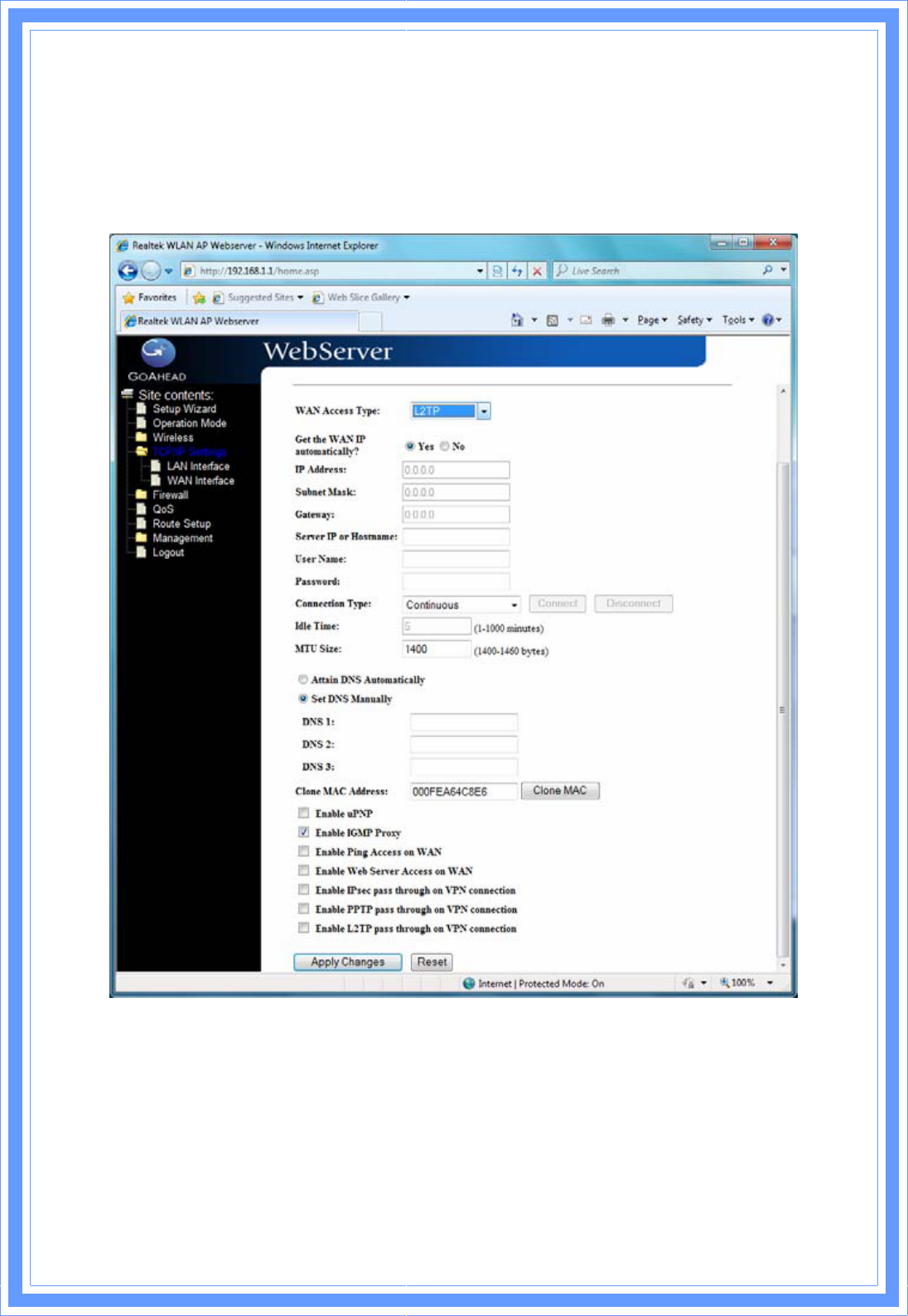
4
9
optional field.
User Name: If you select the L2TP support on WAN interface, fill in the user name and
password to login the PPTP server.
Password: you select the L2TP support on WAN interface; fill in the user name and
password to login the PPTP server.
MTU Size: Fill in the MTU size of MTU Size. The default value is 1400.
Request MPPE Encryption: Click the checkbox to enable request MPPE encryption.
Attain DNS Automatically: Click to select getting DNS address for L2
TP
support.
Please select
Set DNS Manually
if the
L2TP
support is selected.
Set DNS Manually: Click to select getting DNS address for
L2TP
support.
DNS 1: Fill in the IP address of Domain Name Server 1.
DNS 2: Fill in the IP address of Domain Name Server 2.

5
0
DNS 3: Fill in the IP address of Domain Name Server 3.
Clone MAC Address: Fill in the MAC address that is the MAC address to be cloned.
Enable uPNP: Click the checkbox to enable uPNP function.
Enable IGMP Proxy: Click the checkbox to enable IGMP Proxy.
Enable Ping Access on WAN: Click the checkbox to enable WAN ICMP response.
Enable Web Server Access on WAN: Click the checkbox to enable web
configuration from WAN side.
Enable IPsec pass through on VPN connection: Click the checkbox to enable
IPSec packet pass through.
Enable PPTP pass through on VPN connection: Click the checkbox to enable
PPTP packet pass through.
Enable L2TP pass through on VPN connection: Click the checkbox to enable
L2TP packet pass through.
Apply Changes: Click the
Apply Changes
button to complete the new
configuration setting.
Reset: Click the
Reset
button to abort change and recover the previous configuration
setting.
3.6 Firewall
3.6.1 Port Filtering
Entries in this table are used to restrict certain types of data packets from your local
network to Internet through the Gateway. Use of such filters can be helpful in securing or
restricting your local network.
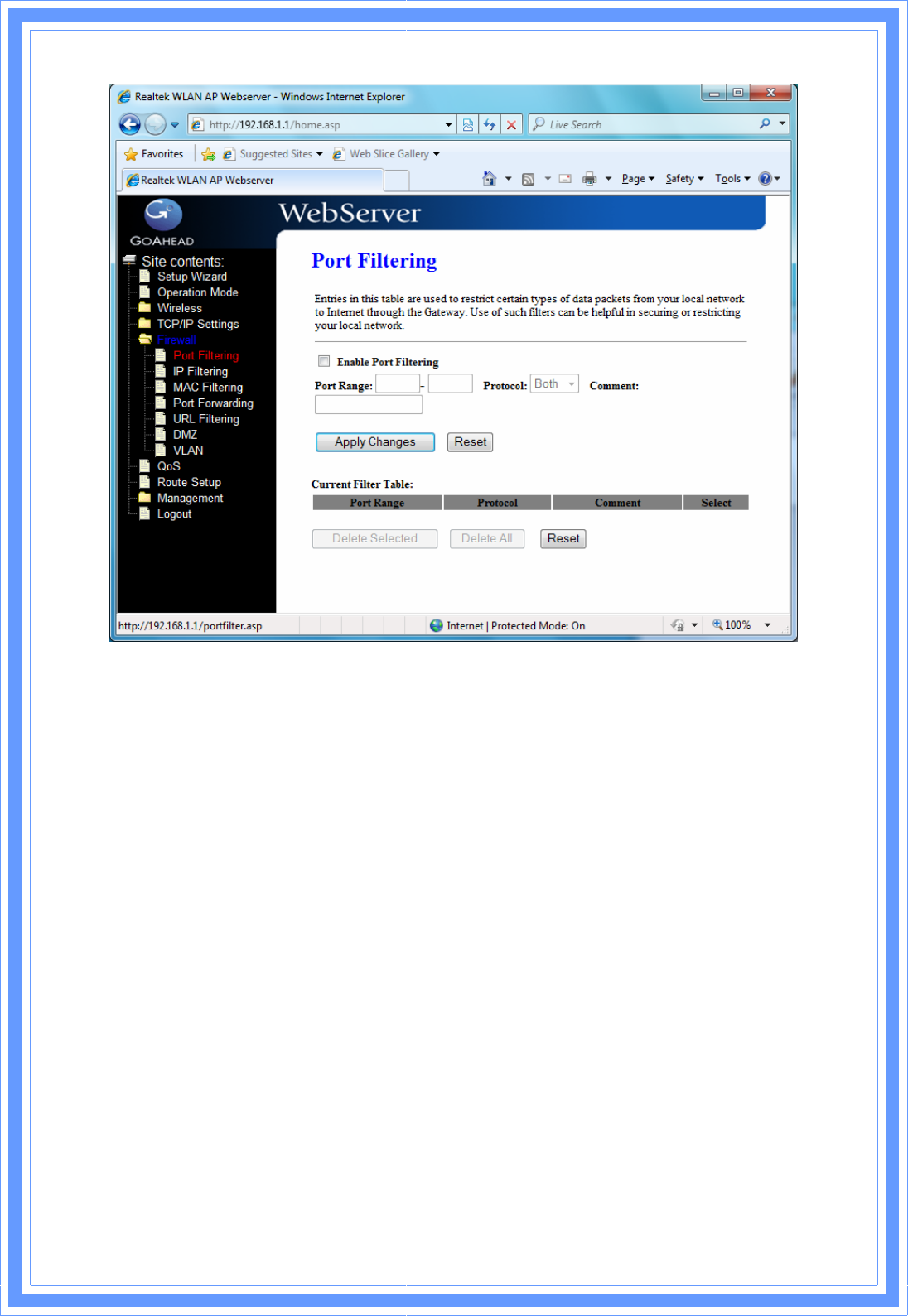
51
Enable Port Filtering: Click to enable the port filtering security function.
Port Range/Protocol/Comments: To restrict data transmission from the local
network on certain ports, fill in the range of start-port and end-port, and the protocol,
also put your comments on it. The
Protocol
can be TCP, UDP or Both.
Comments
let
you know about whys to restrict data from the ports.
3.6.2 IP Filtering
Entries in this table are used to restrict certain types of data packets from your local
network to Internet through the Gateway. Use of such filters can be helpful in securing or
restricting your local network.
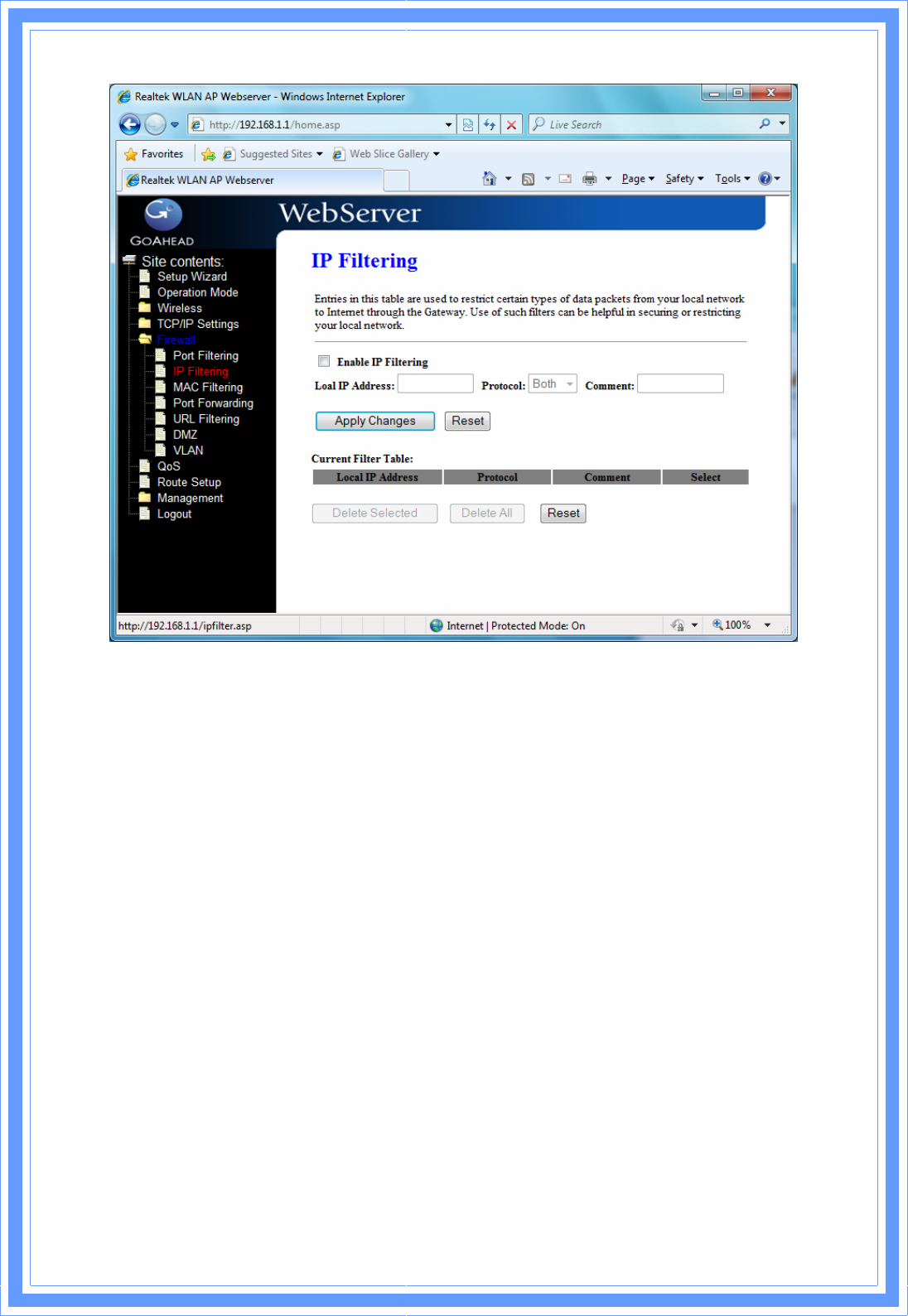
5
2
Enable IP Filtering: Click to enable the IP filtering security function.
Local IP Address/Protocol/Comments: To restrict data transmission from local
network on certain IP addresses, fill in the IP address and the protocol; also put your
comments on it. The
Protocol
can be TCP, UDP or Both.
Comments
let you know
about whys to restrict data from the IP address.
3.6.3 MAC Filtering
Entries in this table are used to restrict certain types of data packets from your local
network to Internet through the Gateway. Use of such filters can be helpful in securing or
restricting your local network.
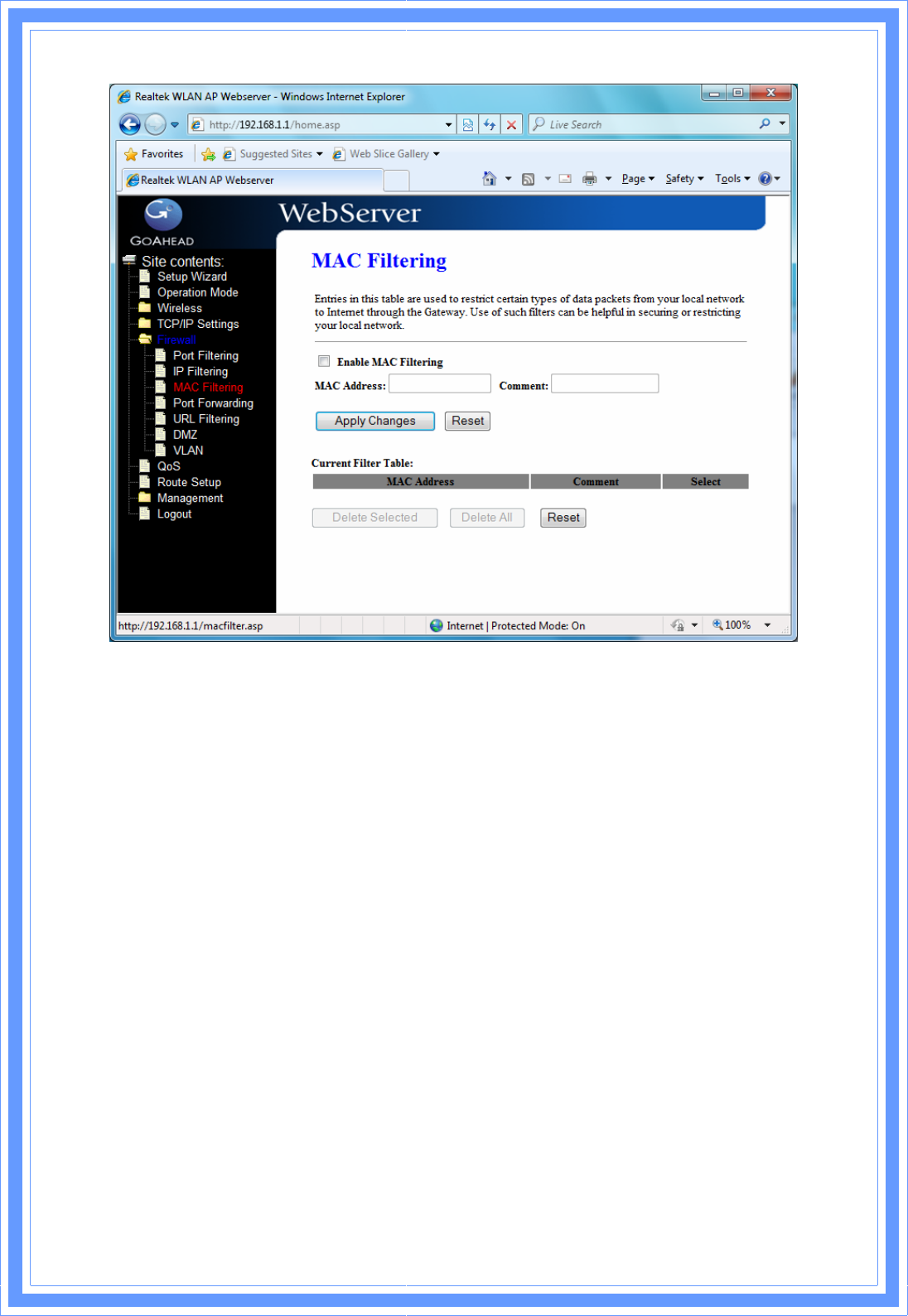
5
3
Enable MAC Filtering: Click to enable the MAC filtering security function.
MAC Address/Comments: To restrict data transmission from local network on
certain MAC addresses, fill in the MAC address and your comments on it.
Comments
let you know about whys to restrict data from the MAC address.
3.6.4 Port Forwarding
Entries in this table allow you to automatically redirect common network services to a
specific machine behind the NAT firewall. These settings are only necessary if you wish
to host some sort of server like a web server or mail server on the private local network
behind your Gateway's NAT firewall.
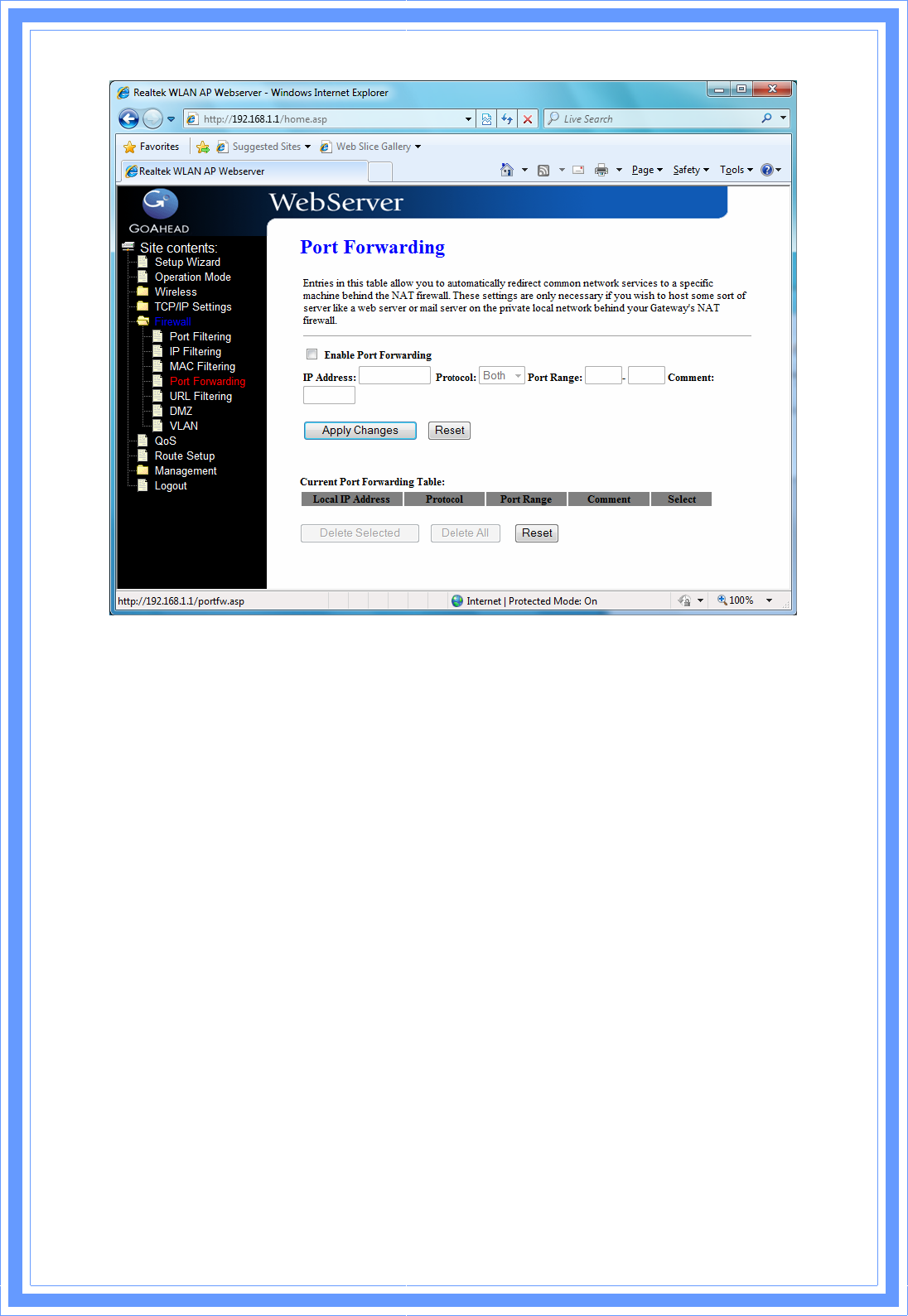
5
4
Enable Port Forwarding: Click to enable the Port Forwarding security function.
Local IP Address/Protocol/Port Range/Comment: To forward data packets
coming from WAN to a specific IP address that hosted in local network behind the NAT
firewall, fill in the IP address, protocol, port range and your comments. The
Protocol
can be TCP, UDP or Both. The
Port Range
is for data transmission.
Comments
let you
know about whys to allow data packets forward to the IP address and port number.
3.6.5 URL Filter
URL Filtering is used to restrict users to access specific websites in internet.
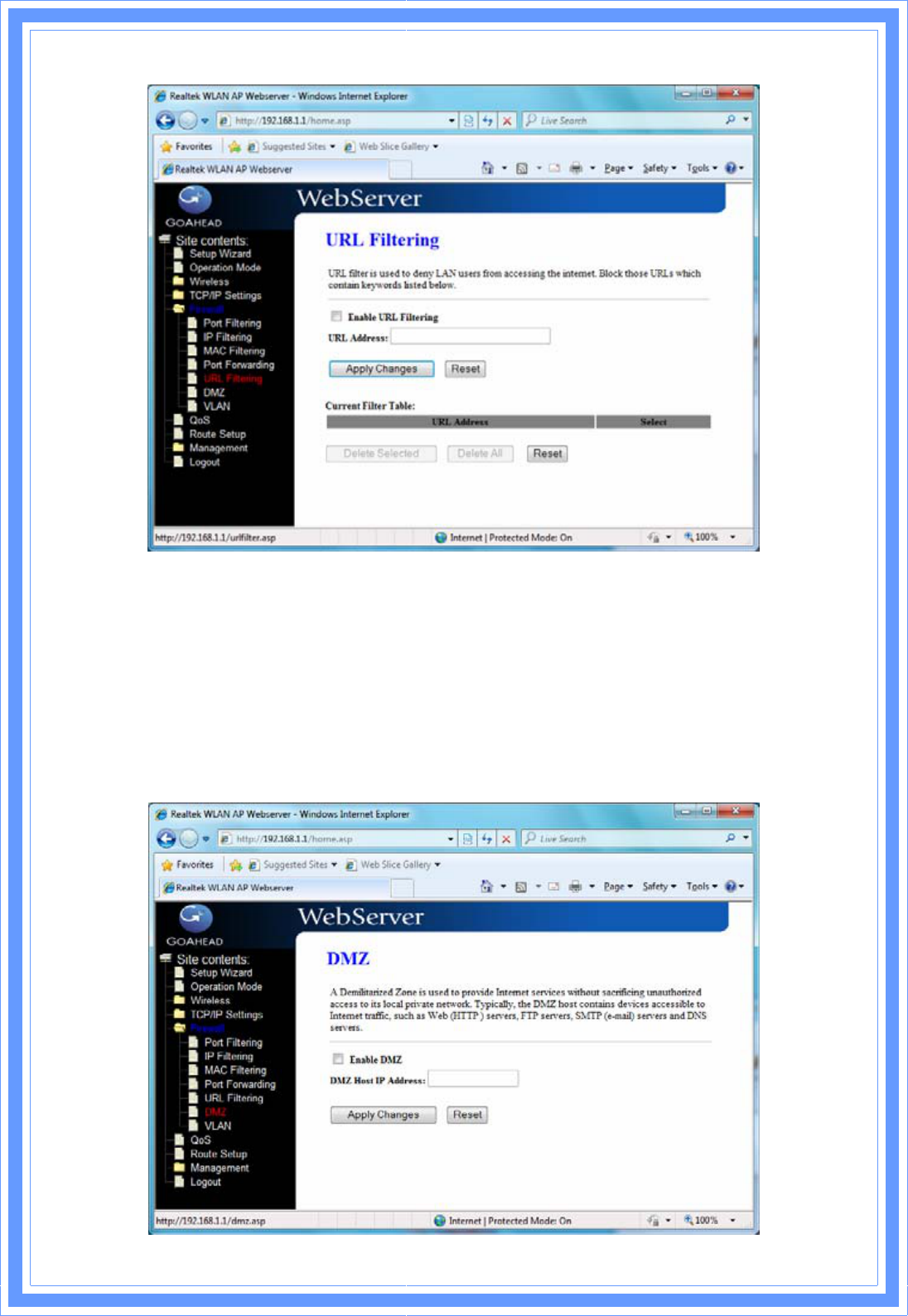
5
5
Enable URL Filtering: Click to enable the URL Filtering function.
URL Address: Add one URL address.
3.6.6 DMZ
A Demilitarized Zone is used to provide Internet services without sacrificing
unauthorized access to its local private network. Typically, the DMZ host contains
devices accessible to Internet traffic, such as Web (HTTP) servers, FTP servers, SMTP
(e-mail) servers and DNS servers.
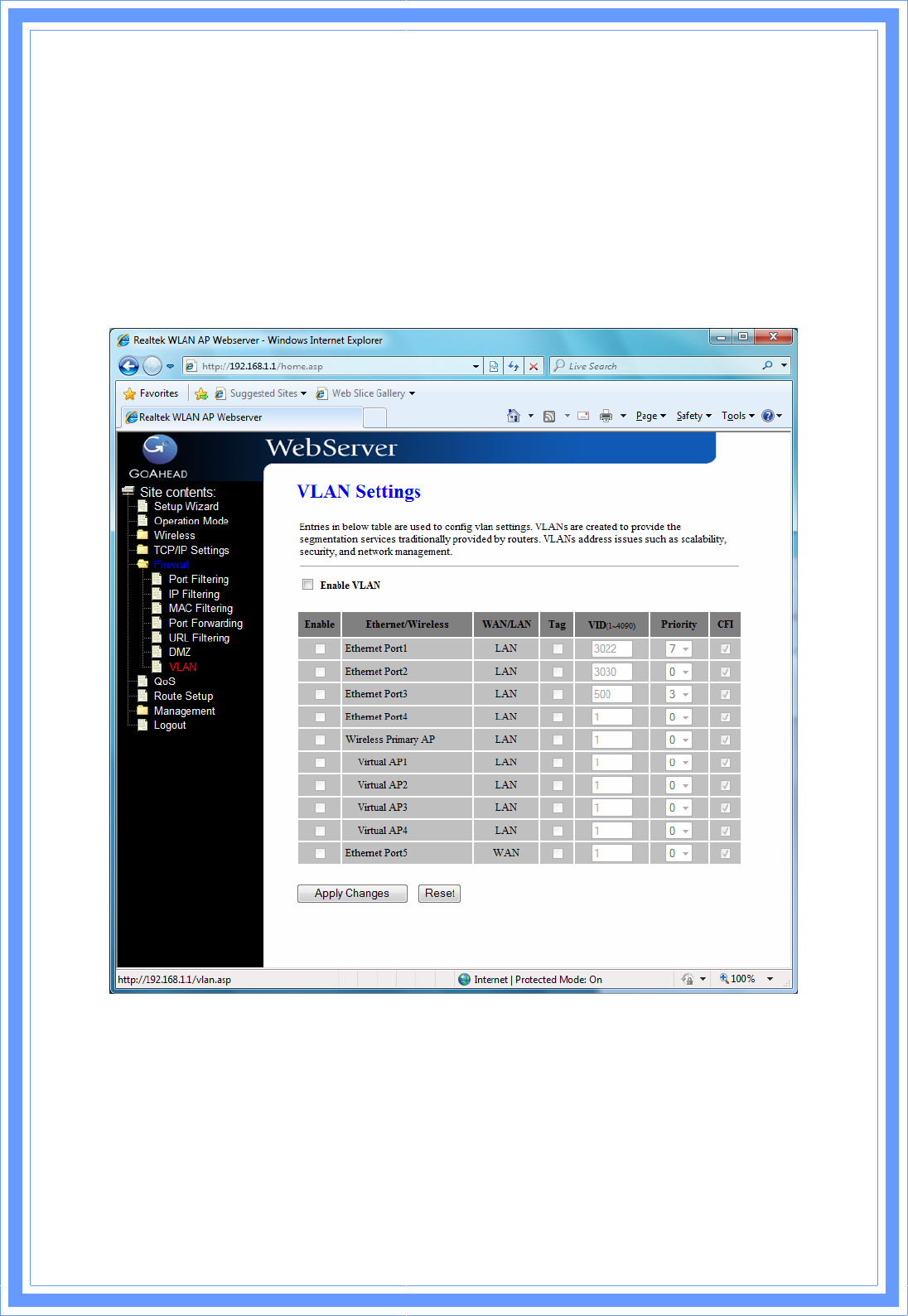
5
6
Enable DMZ: Click to enable the DMZ function.
DMZ Host IP Address: To support DMZ in your firewall design, fill in the IP address
of DMZ host that can be access from the WAN interface.
3.6.7 VLAN
Enter in below table are used to configure VLAN settings. VLANs are created to provide
the segmentation services traditionally provided by routers. VLANs address issue such as
scalability, security, and network management.
3.7 QoS
Entries in this table improve your online gaming experience by ensuring that your game
traffic is prioritized over other network traffic, such as FTP or Web.
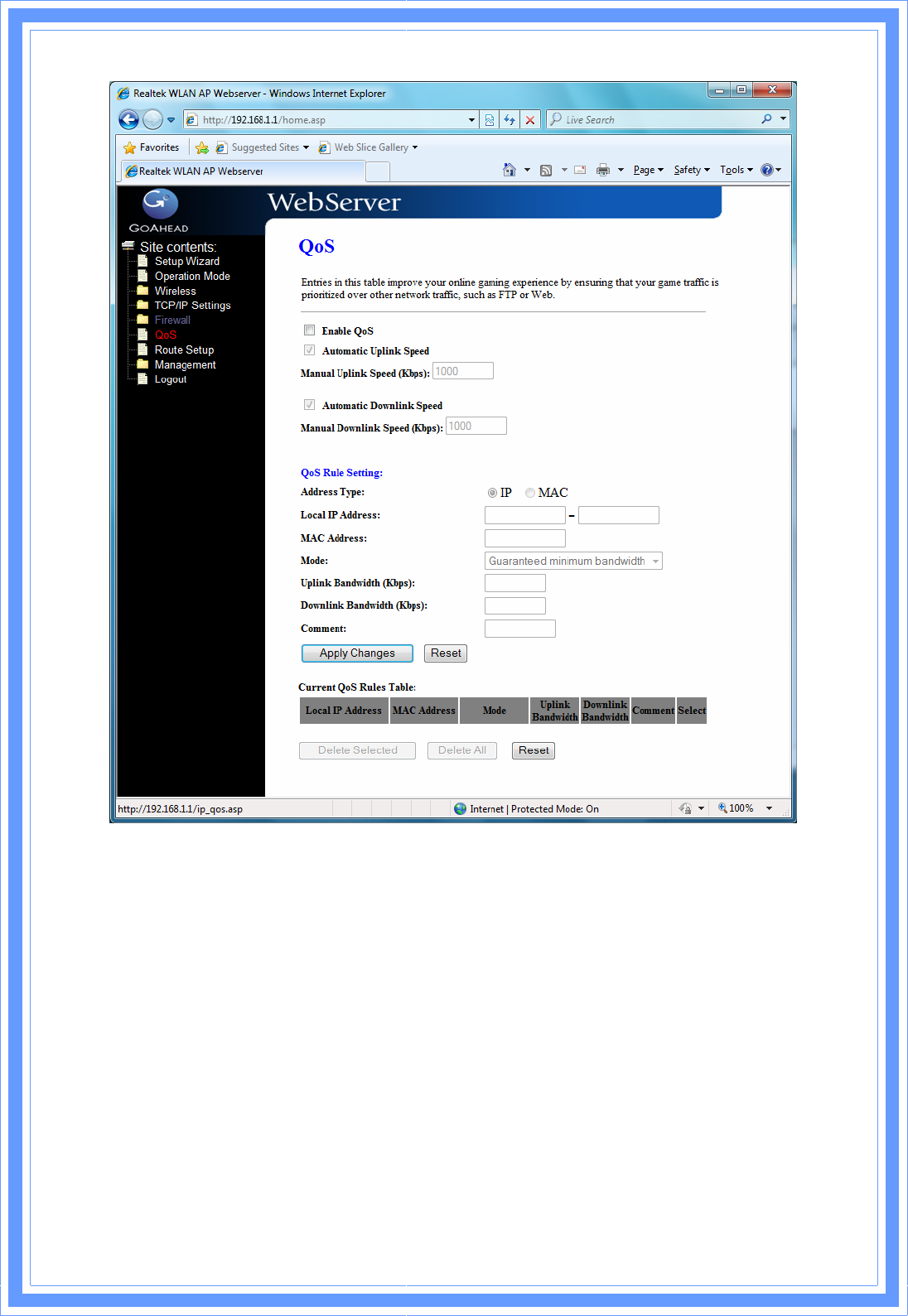
5
7
How to setup your QoS:
1. In QoS Setup Section, Enable QoS feature.
2. Choose Uplink & Downlink Speed: “Automatic” or “Manual”
3. Select Address Type: “IP” or “Address”
4. Configure QoS Rules – Mode(“Guaranteed Minimum bandwidth” &
“Restricted Maximum bandwidth”), Uplink/Downlink Bandwidth,
Comment.
5. Click “Apply Changes” to save QoS configurations.
3.8 Route Setup
This page is used to setup dynamic routing protocol or edit static route entry.
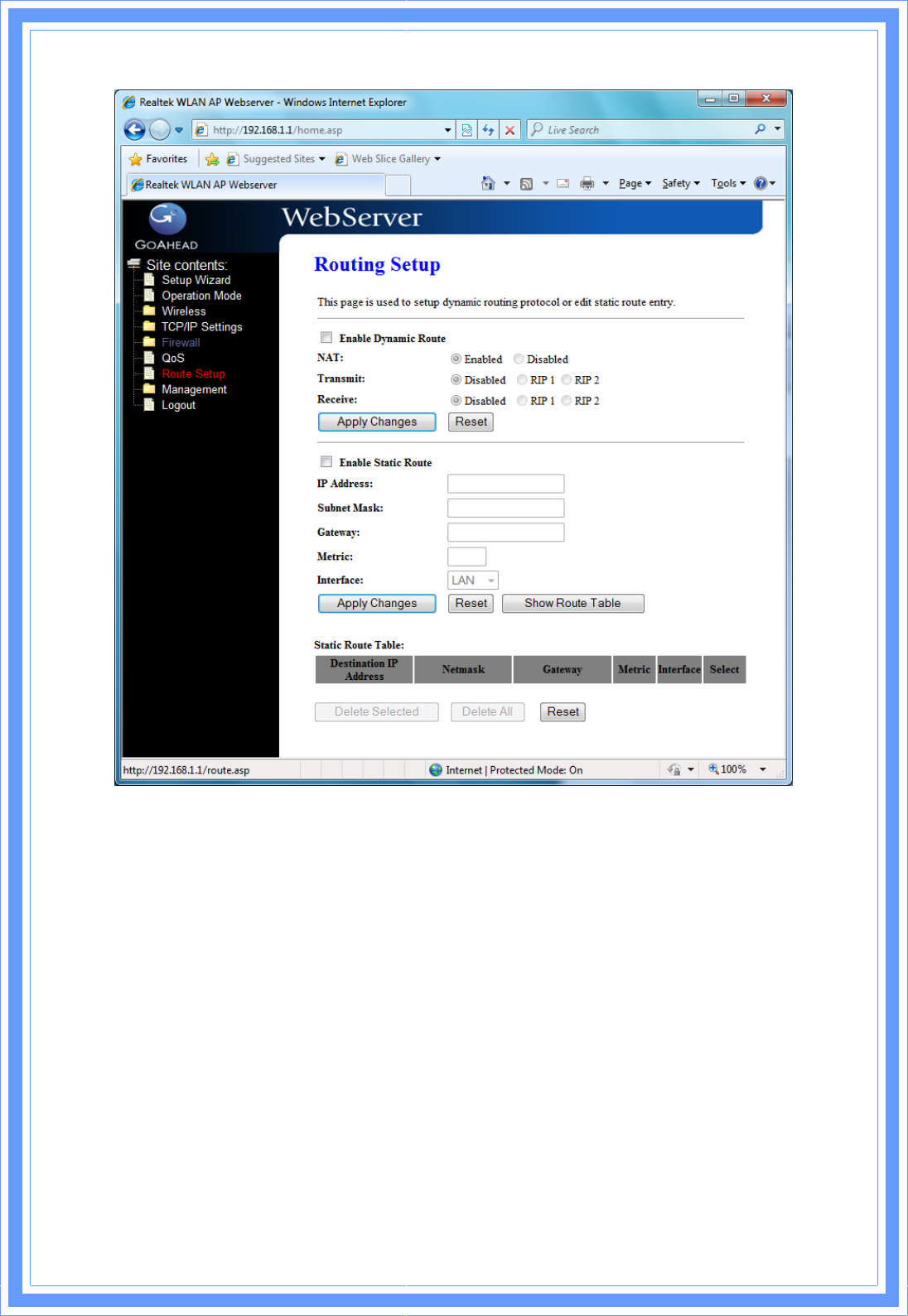
5
8
[Dynamic Route]
Dynamic routing is a technique developed to automatically adjust routing tables in the
event of network failures. The most common dynamic routing protocols is RIP (Routing
Information Protocol), which is very common on small networks.
[Static Route]
It menu allows you to define your own static routes for network traffic. Follow the
instructions below to define a static router:
1. Enter the target IP address in the textbox near ‘IP Address’.
2. Enter the subnet mask in the textbox near ‘Subnet Mask’.
3. Enter the gateway IP address in the textbox near ‘Gateway’.
4. Enter the number of ‘hops’ in the textbox near ‘Metric’ (normally you can set the
value to ‘0’).
5. Select the correct port type in the dropdown box near ‘Interface’.
6. Click the ‘Apply Changes’ button to add the route.

5
9
3.9 Management
3.9.1 Status
This page shows the current status and some basic settings of the device, includes system,
wireless, Ethernet LAN and WAN configuration information.
[System]
Uptime: It shows the duration since WLAN AP Router is powered on.
Firmware version: It shows the firmware version of WLAN AP Router.
[Wireless configuration]
Mode: It shows wireless operation mode
Band: It shows the current wireless operating frequency.
SSID: It shows the SSID of this WLAN AP Router. The SSID is the unique name of WLAN
AP Router and shared among its service area, so all device sat tempts to join the same
wireless network can identify it.
Channel Number: It shows the wireless channel connected currently.
Encryption: It shows the status of encryption function.
Associated Clients: It shows the number of connected clients (or stations, PCs).
BSSID: It shows the BSSID address of the WLAN AP Router BSSID is a six-byte address.
[LAN configuration]
IP Address: It shows the IP address of LAN interfaces of WLAN AP Router.
Subnet Mask: It shows the IP subnet mask of LAN interfaces of WLAN AP Router.
Default Gateway: It shows the default gateway setting for LAN interfaces outgoing
data packets.
DHCP Server: It shows the DHCP server is enabled or not.
MAC Address: It shows the MAC address of LAN interfaces of WLAN AP Router.
[WAN configuration]
Attain IP Protocol: It shows how the WLAN AP Router gets the IP address. The
IP address can be set manually to a fixed one or set dynamically by DHCP server or
attain IP by PPPoE / PPTP connection.
IP Address: It shows the IP address of WAN interface of WLAN AP Router.
Subnet Mask: It shows the IP subnet mask of WAN interface of WLAN AP Router.
Default Gateway: It shows the default gateway setting for WAN interface outgoing
data packets.
MAC Address: It shows the MAC address of WAN interface of WLAN AP Router.
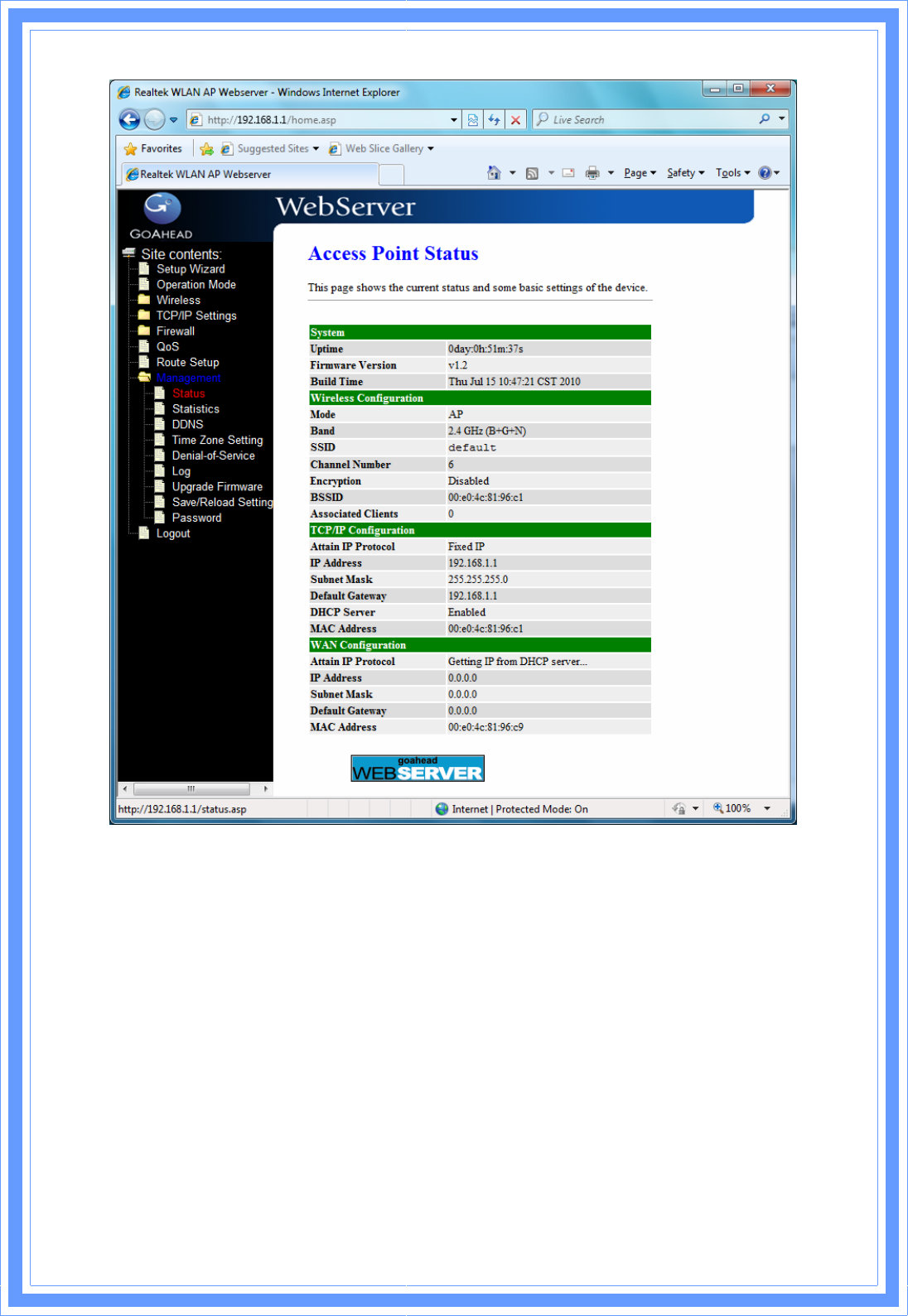
6
0
3.9.2 Statistics
This page shows the packet counters for transmission and reception regarding to
wireless, Ethernet LAN and Ethernet WAN networks.
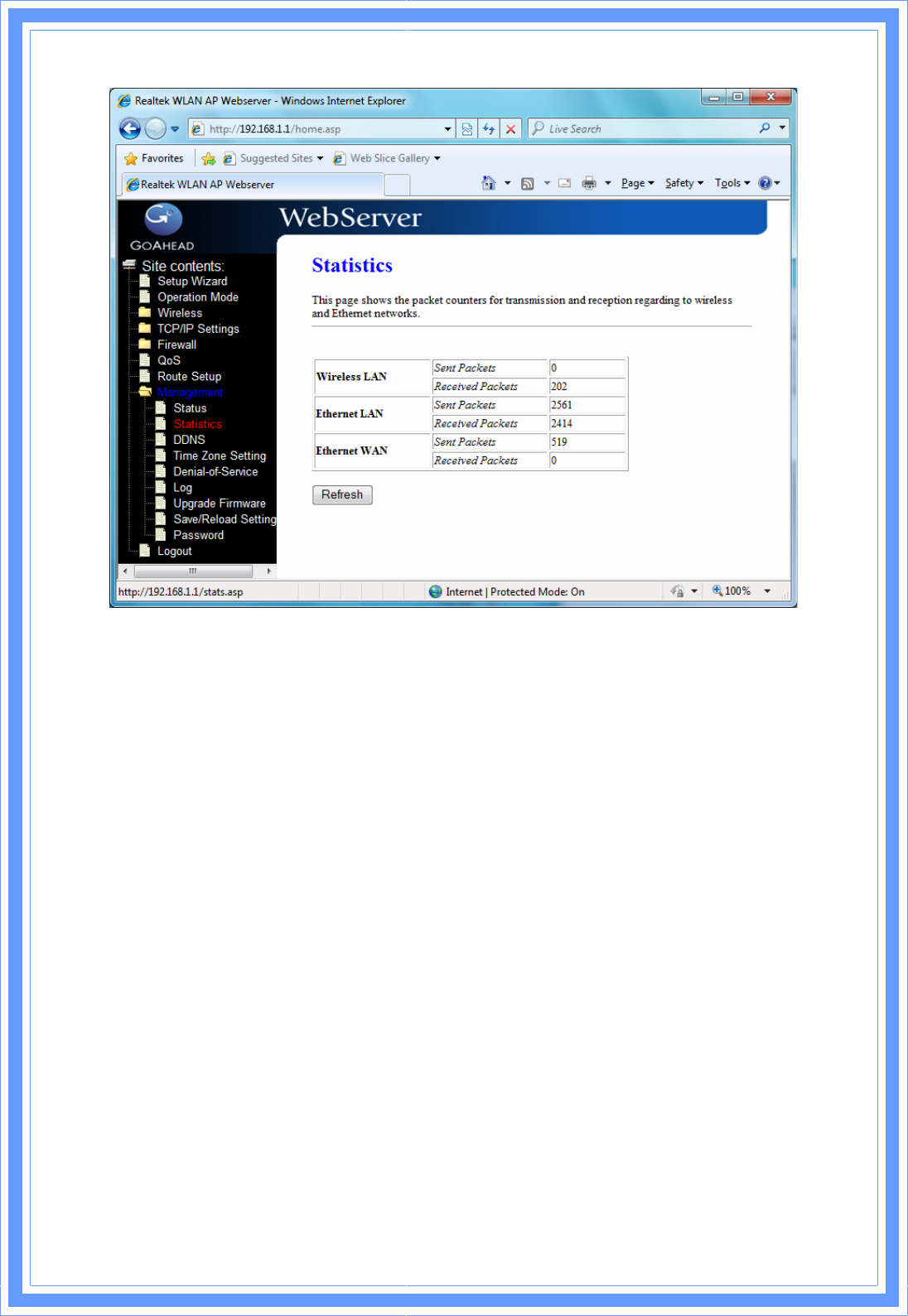
6
1
[Wireless LAN]
Sent Packets:
It shows the statistic count of sent packets on the wireless LAN interface.
Received Packets:
It shows the statistic count of received packets on the wireless LAN
interface.
[Ethernet LAN]
Sent Packets:
It shows the statistic count of sent packets on the Ethernet LAN interface.
Received Packets:
It shows the statistic count of received packets on the Ethernet LAN
interface.
[Ethernet WAN]
Sent Packets:
It shows the statistic count of sent packets on the Ethernet WAN
interface.
Received Packets:
It shows the statistic count of received packets on the Ethernet
WAN interface.
Refresh: Click the refresh the statistic counters on the screen.
3.9.3 DDNS
This page is used to configure Dynamic DNS service to have DNS with dynamic IP
address.
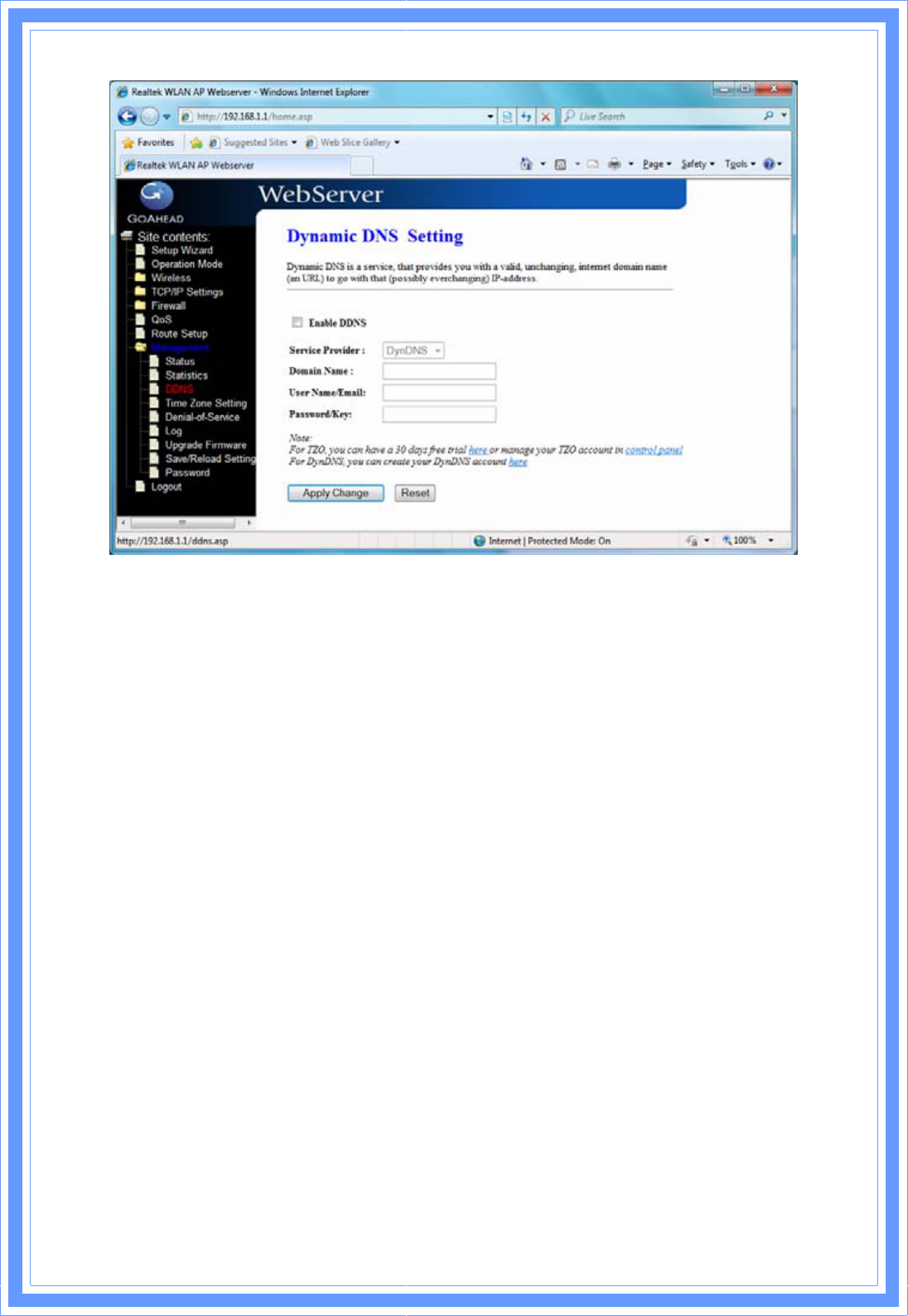
6
2
Enable DDNS: Click the checkbox to enable
DDNS
service.
Service Provider: Click the drop down menu to pickup the right provider.
Domain Name: To configure the Domain Name.
User Name/Email: Configure User Name, Email.
Password/Key: Configure Password, Key.
3.9.4 Time Zone Setting
Click the Reset button to abort change and recover the previous configuration setting.
Current Time: It shows the current time.
Time Zone Select: Click the time zone in your country.
Enable NTP client update: Click the checkbox to enable NTP client update.
NTP Server: Click select default or input NTP server IP address.
Apply Change: Click the
Apply Changes
button to save and enable NTP client
service.
Reset: Click the
Reset
button to abort change and recover the previous configuration
setting.
Refresh: Click the refresh the current time shown on the screen.
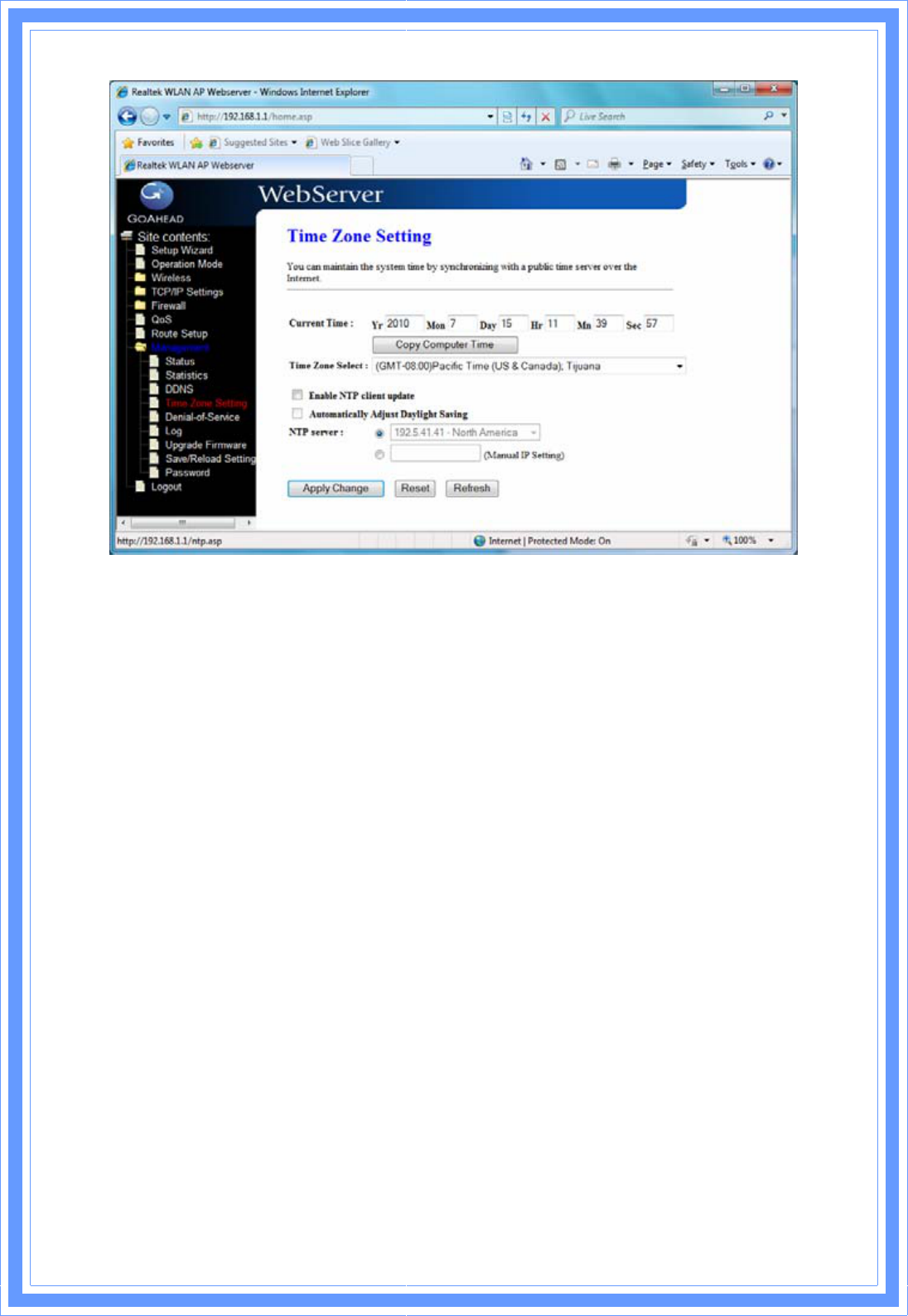
6
3
3.9.5 Denial-of-Service
This page is used to enable and setup protection to prevent attack by hacker’s program.
It provides more security for users.
Enable DoS Prevention: Click the checkbox to enable DoS prevention.
Whole System Flood / Per-Source IP Flood…: Enable and setup prevention in
details.
Select ALL: Click the checkbox to enable all prevention items.
Clear ALL: Click the checkbox to disable all prevention items.
Apply Changes: Click the
Apply Changes
button to save above settings.
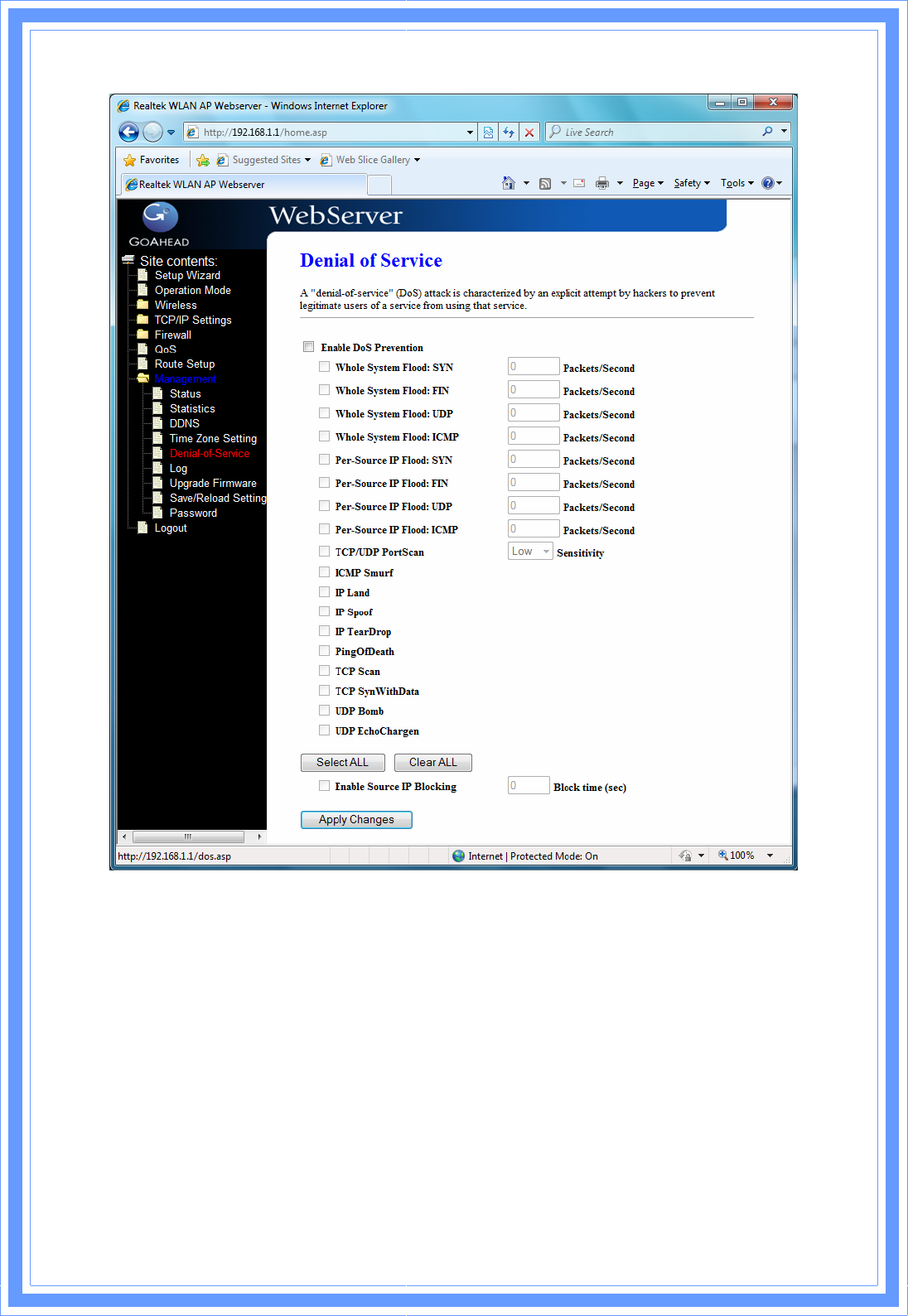
6
4
3.9.6 Log
This page is used to configure the remote log server and shown the current log.
Enable Log: Click the checkbox to enable log.
System all: Show all log of wireless broadband router.
Wireless: Only show wireless log
DoS: Only show Denial-of-Service log
Enable Remote Log: Click the checkbox to enable remote log service.
Log Server IP Address: Input the remote log IP address.
Apply Changes: Click the
Apply Changes
button to save above settings.
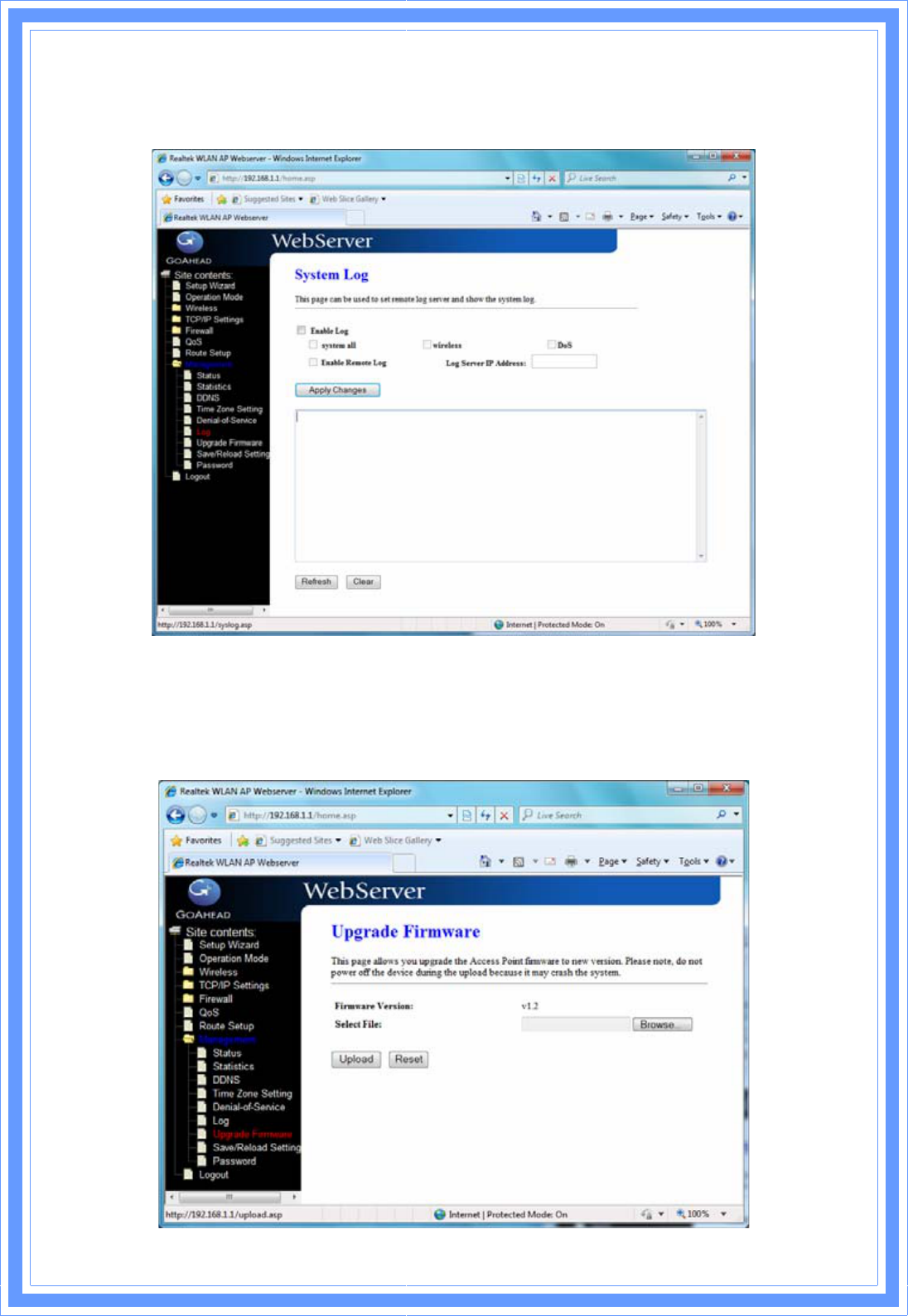
6
5
Refresh: Click the refresh the log shown on the screen.
Clear: Clear log display screen.
3.9.7 Upgrade Firmware
This page allows you upgrade the Access Point firmware to new version. Please note, do
not power off the device during the upload because it may crash the system.
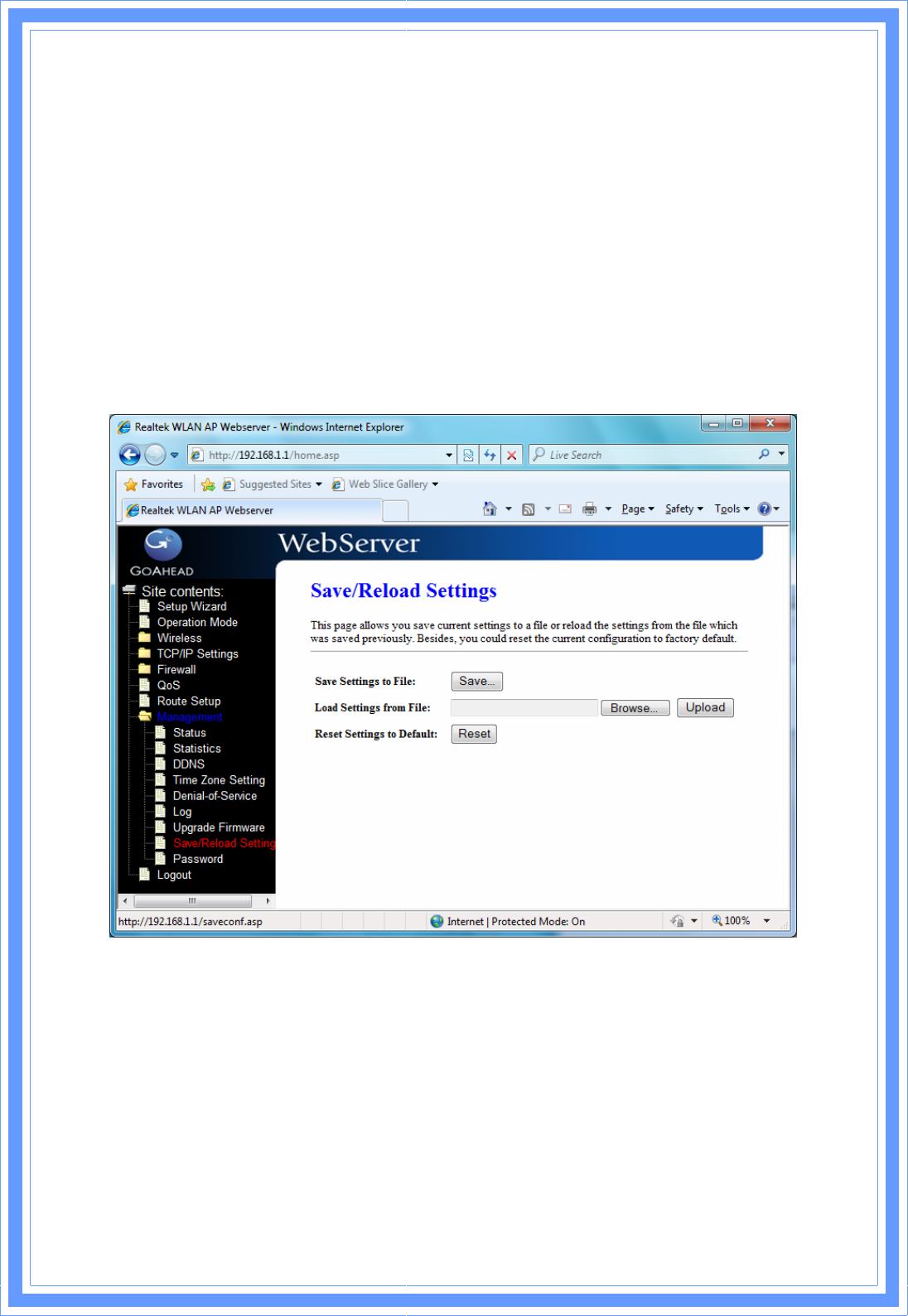
6
6
Select File: Click the
Browse
button to select the new version of web firmware image
file.
Upload: Click the
Upload
button to update the selected web firmware image to the
WLAN Broadband Router.
Reset: Click the
Reset
button to abort change and recover the previous configuration
setting.
3.9.8 Save/Reload Setting
This page allows you save current settings to a file or reload the settings from the file that
was saved previously. Besides, you could reset the current configuration to factory
default.
Save Settings to File: Click the Save button to download the configuration
parameters to your personal computer.
Load Settings from File: Click the Browse button to select the configuration files then
click the Upload button to update the selected configuration to the WLAN Broadband
Router.
Reset Settings to Default: Click the Reset button to reset the configuration parameter
to factory defaults.
3.9.9 Password
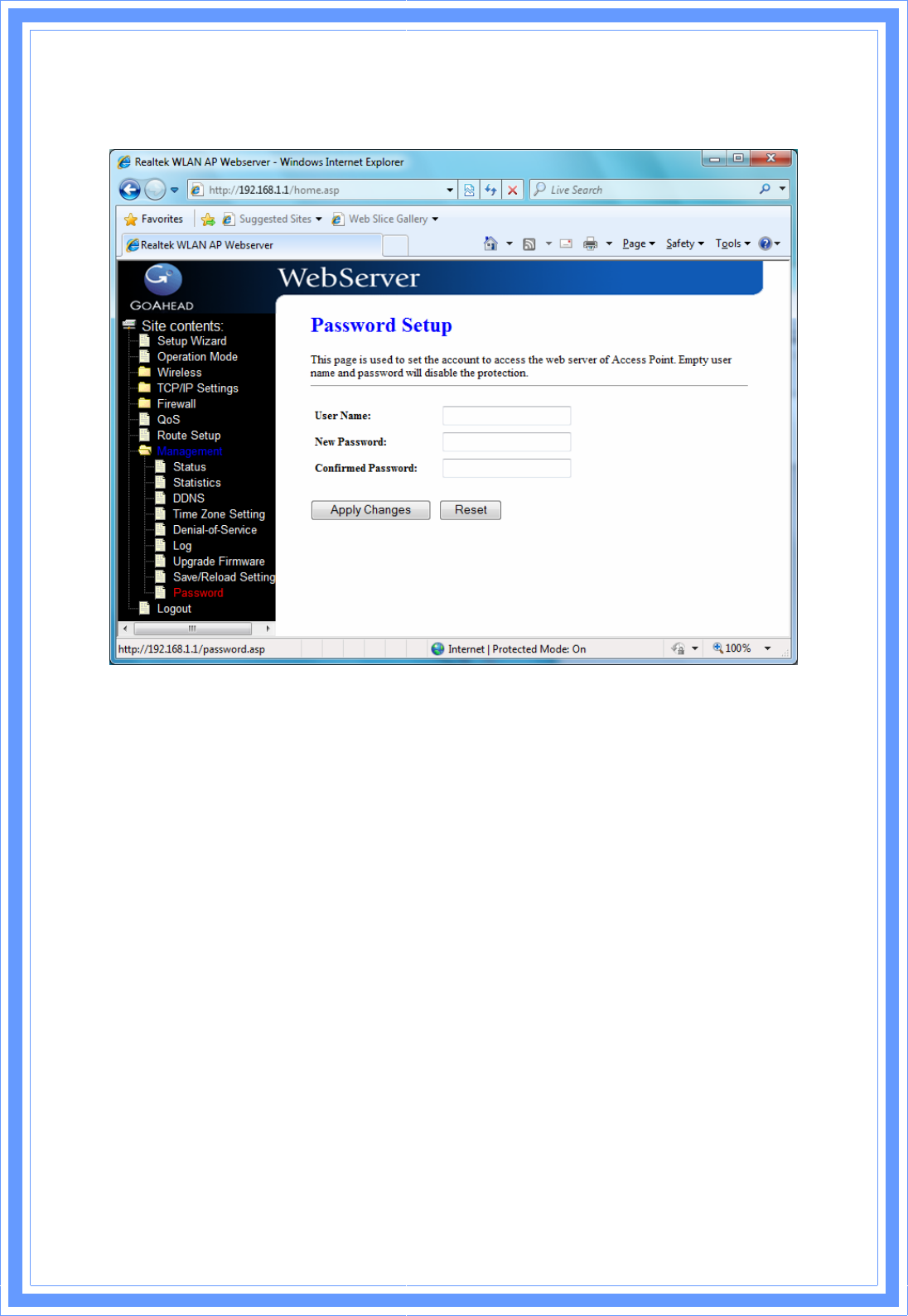
6
7
This page is used to set the account to access the web server of Access Point. Empty user
name and password will disable the protection.
User Name: Fill in the user name for web management login control.
New Password: Fill in the password for web management login control.
Confirmed Password: Because of the password input is invisible, fill in the password
again for confirming purpose.
Apply Changes: Clear the User Name and Password fields to empty, means to apply
no web management login control. Click the Apply Changes button to complete the new
configuration setting.
Reset: Click the Reset button to abort change and recover the previous configuration
setting.